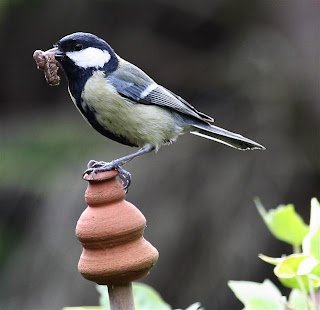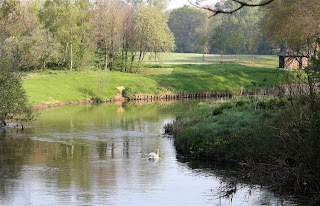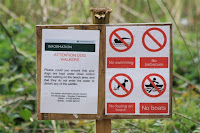Thursday 30 April 2009
Evidence of Nesting: Great Tit
For many years the nest box on the back of the shed has been used exclusively by Blue Tits (Parus caeruleus) but over the last two weeks the activity by a pair of Great Tits (Parus major) led us to believe they may be nesting. During brief breaks from gardening today I was able to get these few shots.

Wednesday 29 April 2009
Robin: How I Grew Up
I have recently been scanning some older "film" photographs taken with an Olympus OM1, and whilst the clarity is not particularly brilliant, I thought I would share this one of a juvenile Robin, taken in the garden 2 years ago. As you can see he is very brown and the whole plumage is finely spotted.
 The next two shots show how I look now, sporting my full adult rusty-red bib and master of my domain.
The next two shots show how I look now, sporting my full adult rusty-red bib and master of my domain.Sunday 26 April 2009
Holmethorpe Spring Bird Race
By invitation I visited Holmethorpe again today for their annual Spring Bird Race and spent some 7 enjoyable hours in the company of local birders Graham (Birding with the Old Grouse) and his wife Sue, Ian, Richard, Steve (North Downs and Beyond) and Gordon plus Tricia (Tricia’s Tales).
Cormorant catching the suns rays
Friday 24 April 2009
Chance Encounter with a Roe Buck
Last week I made a late afternoon visit to Epsom Common in the vain hope of finding a confiding bird to photograph. Well I actually heard more than I saw including Chiffchaffs, Blackcap, Song Thrush, Blackbird, Jays and the resident Crows plus a few Magpies. As I walked beyond the Great Pond out onto High Meadow (open grassland with some scrub thickets) heading for the sounds of Common Whitethroat I had a feeling that something was watching the ‘watcher’ as the hairs on the back of my neck pricked into my shirt collar.
The ‘watcher’ stopped and slowly turned to his right to find a young Roe buck, sporting his fresh soft velvet antlers, staring straight at him. There was no perceivable movement from the watched who continued to stare and the ‘watcher’ tried to remain calm as his pulse rate quickened. Both the watched and the ‘watcher’ seemed to be transfixed in a moment in time. The ‘watcher’ very cautiously removed his camera from its holster, still no change in attitude by the watched, and with a light breeze in favour of the ‘watcher’ the camera was lifted to shooting position and a few shots were fired. A slight twitch by the watched as he ‘nosed’ the air to capture any smell of the ‘watcher’ but still all four feet were rooted to the spot. The ‘watcher’ fired two more volleys and while checking the results the watched started to move, very slowly, away just a matter of a yard or two revealing his tailless rear and then stopped and turned his head towards the ‘watcher’. The eyes of the watched and the ‘watcher’ briefly met once more and as the ‘watcher’ fired his final salvo the watched moved slowly away totally unharmed by this chance encounter.
Wednesday 22 April 2009
Nesting Material.
Tuesday 21 April 2009
Bird Walk @ RHS Wisley Garden.
The participants congregated in the gardens and as usual there were many ‘regular’ faces who have over the years have become, in their words, our birding ‘groupies’ but also very good friends. While I was taking this picture three House Martins were spotted high in the sky, but not by me – drat! [But I saw two today Tuesday - another year tick] So after introductions I led off towards the Wild Garden with David taking up the rear as usual. A Greenfinch confidingly perched on top of a nearby conifer and a male Blackbird was scouring the well trimmed lawn for worms, its favourite snack. Way in front of us on the path alongside the stream, below the Rock Garden was a waddling male Mallard and a Moorhen while one of the visitors located a Long-tailed Tit in the Oak tree. A Wren exploded into song from the undergrowth nearby. It never ceases to amaze me that its song comprises of around 70 – 100 individual notes and are blurted out in a matter of seconds. Next a pair of Dunnock were feeding either side of a pathway but quickly disturbed by other garden visitors walking towards us. Around the corner is one of the large garden seed feeders and everyone had exceptionally good views of a Great Spotted Woodpecker on the feeder together with a Rose-ringed Parakeet while both Chaffinch and Blue Tit tried to land on the perching rings but obviously thought better of it.
So after introductions I led off towards the Wild Garden with David taking up the rear as usual. A Greenfinch confidingly perched on top of a nearby conifer and a male Blackbird was scouring the well trimmed lawn for worms, its favourite snack. Way in front of us on the path alongside the stream, below the Rock Garden was a waddling male Mallard and a Moorhen while one of the visitors located a Long-tailed Tit in the Oak tree. A Wren exploded into song from the undergrowth nearby. It never ceases to amaze me that its song comprises of around 70 – 100 individual notes and are blurted out in a matter of seconds. Next a pair of Dunnock were feeding either side of a pathway but quickly disturbed by other garden visitors walking towards us. Around the corner is one of the large garden seed feeders and everyone had exceptionally good views of a Great Spotted Woodpecker on the feeder together with a Rose-ringed Parakeet while both Chaffinch and Blue Tit tried to land on the perching rings but obviously thought better of it.
At the side of the lake we were closely inspected by female Mallards looking for a free hand out while we marvelled at the iridescent colours on the heads of the males. An Egyptian Goose was also present.
Sorry the bird disappeared into the nest and didn't reappear for his photo call!
Our attention was interrupted by another sighting of Buzzard flying overhead. Two Canada Geese flew over onto the Golf Course. A splinter group were looking over the river where a tree has fallen into the water and requested my ID for a ‘dumpy’ wader they had spotted that was constantly bobbing its rear end. (I was not surprised that they had found something interesting as David had acquainted me with his sighting on his walk into work.) Working its way around the fallen branches on a tiny sand bank and often partly hidden from view, was a COMMON SANDPIPER, easily identified by the clear border between a white belly and grey-brown chest, and a white extension that reaches up to the shoulder that looks like a ‘comma’. This individual is on migration and after feeding up on insects will continue its journey probably northwards. The Grey Wagtail came and joined the Sandpiper while a Moorhen was calmly sitting on a nest where the tip of the fallen branches entered the water.
 As we continued towards the ‘Wildlife Area’ some of the party caught sight of a Grey Heron in flight. We spent a little while looking into this protected area where the river has created a natural pool often frequented by Kingfisher and a bird hide is to be built this year mainly for educational use by children. As we entered the ‘Wildlife Area’ attention was drawn to the Owl box high up on a Pine that for some time has been occupied by Grey Squirrels but has now been cleaned out. Could it be used by something else, well something shot over us and our thoughts were probably a Kestrel. [It was later confirmed by garden staff that a pair of Kestrels have been seen prospecting this box – good news indeed.] Once again intermittent bird song from Robin, Wren and another Blackcap but nothing actually seen apart from Starling and then a Mute Swan on another sand bar in the river as we exited this reserve area.
As we continued towards the ‘Wildlife Area’ some of the party caught sight of a Grey Heron in flight. We spent a little while looking into this protected area where the river has created a natural pool often frequented by Kingfisher and a bird hide is to be built this year mainly for educational use by children. As we entered the ‘Wildlife Area’ attention was drawn to the Owl box high up on a Pine that for some time has been occupied by Grey Squirrels but has now been cleaned out. Could it be used by something else, well something shot over us and our thoughts were probably a Kestrel. [It was later confirmed by garden staff that a pair of Kestrels have been seen prospecting this box – good news indeed.] Once again intermittent bird song from Robin, Wren and another Blackcap but nothing actually seen apart from Starling and then a Mute Swan on another sand bar in the river as we exited this reserve area.
This is the view that you will have from the hide - when it is built.
On the walk back through Howards Field (heather collection) and Pineatum we heard both Green and Great Spotted Woodpeckers calling. All in all not a bad day and it will be interesting to compare the species seen and heard (35) with our next walk in a month’s time.
Sunday 19 April 2009
Up with the Lark!
This morning (Sunday 19th) I intended to rise early to revisit Bookham Common and check for returning Nightingales BUT I overslept! Never mind, I thought, I'll go anyway. It was not a fruitless visit as I 'heard' 4 separate individuals during a half hour sprint around the possible locations. Song Thrushes were also singing prominently and I also had another brief encounter with a pair of Lesser Whitethroats.
On the drive back towards Downside I spotted Skylarks perched on the roadside hedge and managed to get this image while using the car as a hide.
Weekend Walks 18/04/09
On Saturday we decided to visit Frensham Little Pond. A dip into the wooded area adjoining the car park produced Chiffchaffs, Blackcaps (2 males & 1 female), Wren and Great Tits plus Great Woodpecker calling and Green Woodpecker ‘yaffaling’ some distance away.

Male Blackcap
At the water’s edge several dog owners were allowing their beasts to enter the water despite signs around the pond banning this activity to protect the wildlife. (The owners obviously all need an eye sight test!) 
 On the water were Great-crested Grebe (2), Coot, Mallard, Mute Swan and a Canada Goose.
On the water were Great-crested Grebe (2), Coot, Mallard, Mute Swan and a Canada Goose.We listened to the rhythmic song of several Reed Warblers and the scratchy sounds from a Sedge Warbler but only one very brief sighting of the former dashing across the top of the reeds.
Below is my 2nd pair of eyes scanning the reed beds for any sign of life.

Willow Warblers were singing from their high perches. Quite a few Blue Tits and this individual posed long enough for its portrait.

On the way home we stopped off at Bookham Common and were rewarded with a brief glimpse of a LESSER WHITETHROAT confirmed by its distinctive alarm call and then singing from within low scrub. Again Blackcaps, Chiffchaffs and Chaffinches were everywhere.
Butterflies seen today were Peacock, Comma, Green Veined White and plenty of Orange Tips, including this female.
Wednesday 15 April 2009
A better way to start the day?
On Tuesday with an aching back due to incorrectly lifting and moving a pot in the garden over the weekend (no comments please, it’s my own fault!) I decided to leave early for work and dropped into Bookham Common to stretch the legs. The early morning sun was still hidden behind cloud so not brilliant light for any pictures but I took the camera just in case. While heading towards the Blackthorn thickets four Jays noisily flew over and the other sounds were from a Robin high on his song perch confirming his overnight survival, a Greenfinch ‘sneezing', and a Blackcap started warbling very close by. Could I get a shot as I crept around the thicket? No he was deep in the shade and responded to my presence by flying away. Next on the list was Chiffchaff and while thinking about a possible photo my attention was broken by the scolding call of, did I hear correctly, yes, a Common Whitethroat [first for the year]. Again I crept closer and closer as it tantalisingly moved ahead of me through an area of brambles providing brief glimpses but never still enough for a photo.
After we parted I saw both Blackbird and Wren in full song plus a Willow Warbler repeating it’s wistfully descending call from a very tall birch and definitely too high for a photo call. Just about to return to the car and the beautiful repeated phrases from of a Song Thrush caught my attention. I stealthily moved closer and closer to his high perch and whilst partially obscured by branches I finally managed one half decent shot.
Monday 13 April 2009
Afternoon Walk at Stoke Park.
At long last the weather improved and we drove to Stoke Lake & Watermeadows for an early afternoon walk.
 Following the path to the lake we saw Jay, Blackbird, Robin and Chifchaff calling. The next sound was the call of a COMMON TERN flying overhead. Hopefully they will take up residence on the raft on the lake and successfully breed providing there is no disturbance this year from 'hooligans' swimming out to the raft and destroying their man-made habitat.
Following the path to the lake we saw Jay, Blackbird, Robin and Chifchaff calling. The next sound was the call of a COMMON TERN flying overhead. Hopefully they will take up residence on the raft on the lake and successfully breed providing there is no disturbance this year from 'hooligans' swimming out to the raft and destroying their man-made habitat.Saturday 11 April 2009
Long-tailed Tit (Aegithalos caudatus)
A pair of Long-tailed Tits has been visiting our garden since late January. They usually announce themselves with their soft “tupp” or thin “si-si-si” calls as they communicate with one another whilst searching for tiny insects amongst the plants or taking seed from the feeders. Like most small birds they rarely sit still for very long and yesterday, late afternoon, was no exception as they appeared under the patio canopy close to the dining room window. Fortunately the camera was by my side so I was able to fire off a few frames through the double glazing as they darted from perch to perch and then disappeared just as quickly as they had first appeared.
Subscribe to:
Posts (Atom)



